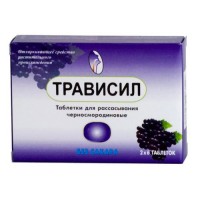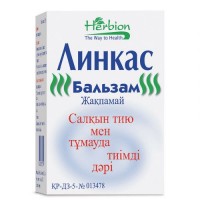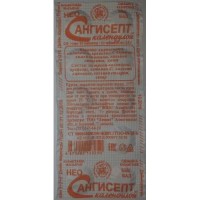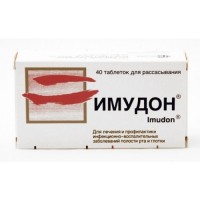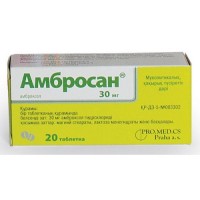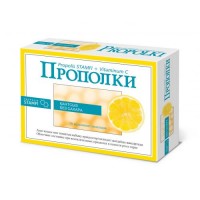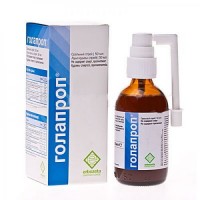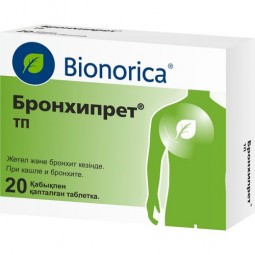Angal® C 30 ml spray topically with lemon flavor
- $17.40
Sku:
9b67d2ab53de
Brand:
Qualiphar (Belgium)
The instruction for medical use of the drug Angal® About the Trade name of Angal® About the International unlicensed name Is not present the Dosage form Spray for topical administration with taste of a lemon Structure 100 ml of solution contain active agents: chlorhexidina digluconate of 20% solution of 1.064 g of lidocaine hydrochloride of 0.050 g excipients: citric acid monohydrate, a sucralose fragrance lemon 502336T, propylene glycol, glycerin, alcohol of 96%, water purified. The description Transparent colourless solution with a smell of a lemon and alcohol, with taste of a lemon. Pharmacotherapeutic group Drugs for treatment of diseases of a respiratory system. Drugs for treatment of diseases of a throat. The ATX R02A code the Pharmacological Drug Angal® C properties has local analgeziruyushchy and antibacterial effect. Drug reduces inflammation of a throat, reducing a possibility of development of heavier bacterial infections of a throat, and relieves pain at irritation and swallowing. The pharmacokinetics Absorption Chlorhexidin is badly soaked up at oral or topical administration. After local drawing on the uninjured skin, chlorhexidin the digluconate is adsorbed on enveloping layers of skin that results in steady antimicrobic effect. At pharmacokinetic researches it was established that about 30% of a chlorhexidin remain in an oral cavity after rinsing then chlorhexidin it is gradually removed with saliva. Speed of system absorption of lidocaine varies depending on the place and a way of introduction. It is quickly soaked up from digestive tract, mucous membranes and through the injured skin, however, before entering system blood circulation it almost completely breaks up. At healthy adults the use of 2% of solution for rinsing of a mouth did not lead to emergence of the found concentration of lidocaine in plasma. At children with the weakened immunity and adults lidocaine reabsorbirutsya through a mucous membrane of an oral cavity in plasma. These values are about 0.2 mkg/ml, and toxic concentration in plasma makes 5 mkg/ml. The anesthetizing effect of lidocaine at topical administration develops quickly - in 2 - 5 minutes and proceeds within 30 – 45 minutes. Anesthesia is superficial and does not spread to submucosal structures. Chlorhexidin's distribution strongly contacts proteins in saliva. Lidocaine is well distributed on fabrics (kidneys, lungs, a liver, heart, fatty tissue). Lidocaine gets through a blood-brain barrier and a placenta and is excreted in maternal milk. Metabolism and excretion Chlorhexidin does not collect in an organism. It is badly metabolized. After intake of 300 mg of a chlorhexidin of a digluconate about 90% of a dose are removed with excrements through bile, less than 1% are removed with urine. Lidocaine is metabolized during the first passing through a liver, and its bioavailability after oral administration is 35%. 90% deetilirutsya in a liver. The first two metabolites are pharmacological active. Some patients have these two metabolites make toxic impact on the central nervous system. Lidocaine is removed from an organism in the form of metabolites through kidneys, 10% to be brought out of an organism in the form of not changed substance. Biological semi-removal of lidocaine happens from 1.5 to 2 hours at adults. Biological semi-removal of metabolites of lidocaine happens from 2nd to 10 hours. The Lidocaine pharmacodynamics a hydrochloride represents peripheral anesthetic of amide type. Being local anesthetic, lidocaine possesses the same mechanism of action, as other drugs of this group, it blocks generation and carrying out nervous impulses in sensitive, motive and vegetative nerve fibrils. It has direct impact on cell membranes, inhibiting receipt of ions of sodium in nerve fibrils through membranes. Due to the progressing distribution of the anesthetizing effect the threshold of electric excitement increases in peripheral nerves, carrying out a nervous impulse slows down, and reproduction of action potential is weakened that finally, leads to full blocking of a nervous impulse. In general, local anesthetics block autonomic nerves, small quicker not myelinized (feeling of pain) and small myelinized (feeling of pain, temperature), than the large myelinized fibers (feeling of touch, pressure). At molecular level lidocaine specifically blocks natrium ion channels in an inactive state that interferes with generation of action potential, preventing carrying out a nervous impulse at local use of lidocaine near a nerve. Impact on peripheral nerves is important when using lidocaine as local anesthetic. The ratio between efficiency and toxicity is favorable. The allergic reactions caused by lidocaine are observed very seldom. Besides, when blocking conductivity of peripheral nerves, local anesthetics influence all bodies in which the conductivity impulse appears. Impact on the central nervous system, autonomous a ganglion, neuromuscular connection and all forms of muscle fibers was observed. Lidocaine is also antiarrhytmic drug of class 1B. Chlorhexidin is encore-biguanidnym the antiseptic agent making antibacterial impact, as on gram-positive (for example, Micrococcus sp., Staphylococcus sp., Bacillus sp., Clostridium sp., Corinebacterium sp.) and to a lesser extent on gram-negative microorganisms, mainly on a vegetative form (at the room temperature it is inefficient concerning bacterial spores). It also possesses antimycotic action concerning dermatophytes and mushrooms. It quickly blocks infectious activity of some lipophilic viruses (for example an influenza virus, a virus of herpes, HIV). Drug works as bakteriostatik in low concentration, and in high concentrations has bactericidal effect. Chlorhexidin bears a positive charge, thus, it is absorbed on negatively charged sites of a bacterial cell wall and on extracellular structures. Absorption is specific and is localized on corresponding, containing phosphates, sites of a bacterial cell wall. Chlorhexidin contacts a cytoplasmic membrane of a bacterium. He is absorbed on the negatively charged surface of teeth, a dental plaque or a mucous membrane of a mouth, than its long presence at an oral cavity is caused. The efficiency of antiseptic agents and disinfectants depends on concentration, temperature and time of influence. Indications of Angal® About spray it is used for: • treatment of an infection of a mucous membrane of a mouth (stomatitis, ulitis) and throat (pharyngitis) • local anesthesia at inflammation of a throat. • relief of symptoms of a tonsillitis and irritation of a throat (painful swallowing, irritation). A route of administration and doses For topical administration. Adults and teenagers are more senior than 12 years: from 3 to 5 consecutive pressing the spray button, the procedure to repeat from 6 do10 once a day. To children 6 years are more senior: from 2 to 3 consecutive pressing the spray button. From 3 to 5 times a day. Drug is intended only for individual use. Use more than one person can lead to spread of an infection. Before use Widely open a mouth, turn the spray send the spray to perpendicularly side of a pharynx and press on a bottle. spray button. At the time of dispersion hold the breath. After each use return the spray in a starting position in a downward direction for blocking. If drug is not used for some time, after the last use it is recommended to clean a spray opening, following the instructions given below: 1. turn a bottle upside down and press the spray button until the solution which is in the adapter is not completely removed (spraying of solution will stop), 2. pick up the spray phone from an opening for dispersion and place it in the container with warm water for several minutes, 3. take a spray tube from water and dry up, 4. for dispersion blocking attach a tube of the spray so that it was turned to a bottom. This drug is intended for symptomatic treatment, and should not be used for long-term treatment. If the condition of the patient does not improve within 3-4 days, it is desirable to consult with the doctor. The maximum single dose for adults makes 0.85 mg of a chlorhexidin and 0.21 mg of lidocaine. Maximum daily dose of a chlorhexidin of 8.5 mg and 2.1 mg of lidocaine. By each pressing a nozzle 0.085 ml of solution are sprayed. Side effects At local, limited in time, use in an oral cavity and in a throat with observance of the recommended dose drug is transferred well. Often (≥1/100, & lt, 1/10) - skin reactions of hypersensitivity - nausea, vomiting, pains in a stomach Seldom (≥1/10000, & lt, 1/1000) - heavy allergic reactions, including an acute anaphylaxis - contact dermatitis Very seldom (& lt, 1/10,000) - a small tortoiseshell It is unknown - a methemoglobinemia - the delayed allergic reaction (contact allergy, a photosensitization) or other local reactions on skin or teeth - alarm, excitement, euphoria - drowsiness, dizziness, a disorientation, confusion of consciousness (including speech confusion), vertigo, a tremor, psychosis, nervousness, paresthesia, numbness, spasms, a loss of consciousness and a coma - a disorder of vision, including out-of-focus sight and doubling in eyes - a ring in ears - asthma, breath difficulty, a syndrome of respiratory insufficiency, respiratory depression, an apnoea - difficulty when swallowing, ulcers on a mucous membrane of an oral cavity - peeling of a mucous membrane in oral cavities, hypostasis of a parotid gland - muscular spasms or a tremor - the general weakness, temporary distortion of flavoring feelings or burning sensation in language, feeling of heat or cold At long and continuous use of a chlorhexidin in an oral cavity can temporarily appear brown coloring of teeth. However, this plaque can be removed. Descriptions of cases of coloring of teeth at use of drug in a throat are absent. Contraindications - hypersensitivity to any component of drug - children's age are younger than 6 years - alcohol addiction Medicinal interactions Lidokain is well-known inhibitor of CYP1A2 liver enzyme, to a lesser extent isoenzymes 2D6 and 3A4, but interaction with these enzymes at the recommended use is clinically insignificant. It is not necessary to apply lidocaine together with other antiseptic agents which contain heavy metals. The ionophoresis of vasoactive substances can significantly influence transdermalny delivery of lidocaine. In literature clinically insignificant interaction of lidocaine with the following medicines is described: blockers of neuromuscular carrying out, antiarrhytmic drugs (meksiletin, Phenytoinum, procaineamide, propranolol), hydantoins (antikonvulsant), epinephrine, opiates, beta-blockers, Cimetidinum. At patients with the myocardial infarction caused by the cocaine use clinically insignificant interaction was also observed. Patients should not use drug together with cholinesterase inhibitors (for example, neostigmin, distigmin, pyridostigmine) or with other medicines for treatment of a myasthenia. During drug use the patients are not recommended to use at the same time other antiseptic drugs of local action. This condition does not extend to pastils of Angal® which part also is chlorhexidin and lidocaine, as well as composition of spray. The single dose of spray should be replaced with a single dose of pastils. Patients should not exceed a daily dose of administration of drug, combining spray and pastils. It is not recommended to use a combination of spray and pastils to children. In concentration of 0.05% chlorhexidin the digluconate is not combined with salt of tetraboric acid, bicarbonates, carbonates, chlorides, citrates, nitrates, phosphates, sulfates and with a set of the painting additives forming almost insoluble salts which can drop out in a deposit of solution. The solutions containing chlorhexidin are not compatible to some types of soap and other anion-active substances (for example, alginata, tragacanth gums, almost insoluble powders, such as kaolin and also almost insoluble impurity of calcium, magnesium or zinc) which are usually provided in toothpastes. Special instructions In the bacterial infections which are followed by fervescence, Angal® With it is applied as additional medicine. The patients having chronic heart failure or disturbances of functions of a liver and also at the same time accepting antiarrhytmic means of class 1B need to be careful when prescribing drug, because of danger of strengthening of toxic effect of lidocaine. It is necessary to be careful at use of this means to the patients predisposed to emergence of allergic reactions. Use of Angal® With patients with diabetes as it does not contain sucrose is allowed. It is not necessary to use drug continuously, longer than 3-4 days, or it is too frequent. It is necessary to use drug only for necessary mitigation of symptoms of pain and irritation. It is necessary to avoid contact with eyes and ears. At hit of drug in eyes they should be washed with clear water within at least 15 minutes, holding at the same time eyelids opened. It is not necessary to use drug directly later or at meal time. Drug is not compatible to some substances which usually are present at composition of toothpastes therefore the period between administration of drug and use of toothpaste has to make not less than 30 minutes. 100 ml of solution contain 25 g of ethanol. Patients with diseases of a liver and epilepsy should take into account the fact that the single dose for adults contains 99 mg of ethanol that is equivalent to 2.51 ml of beer or 1.05 ml of wine and the single dose for children from 6 to 12 years contains 60 mg of ethanol that is equivalent to 1.51 ml of beer or 0.63 ml of wine. It is harmful to the people having alcoholism. Also it should be considered to pregnant women (nursing mothers), children and representatives of groups of the increased risk, for example patients with diseases of a liver or epilepsy. Pregnancy and the period of a lactation Experience of use is absent, use of drug during pregnancy and in the period of a lactation perhaps in cases when the expected advantage of therapy for mother exceeds potential risk for a fruit and the child. Features of influence of medicine on ability to run the vehicle or potentially dangerous mechanisms of the Research on an opportunity to drive the car or potentially dangerous mechanisms were not carried out. Overdose In spite of the fact that this medicine contains a small part of a toxic dose and use of drug is limited to topical administration, it is necessary to consider a possibility of overdose by negligence, especially in case of use for treatment of children. Chlorhexidin is soaked up in very insignificant quantities from digestive tract. Absorption of lidocaine is faster, however, its bioavailability is only 35%. The toxicity was connected with concentration of lidocaine in plasma, the exceeding 6 mg/l. After reception of overdoses (more than 1 bottle a day) perhaps disturbances from deglutitory reflexes (decrease in control over a deglutitory reflex). System intoxication is result of influence on the central nervous system and cardiovascular systems. The first symptoms of overdose are shown as disturbance from the central nervous system. The symptoms arising in system intoxication: - disturbance of the central nervous system: a headache, hallucinations, dizziness, drowsiness, arousing, sonitus, paresthesias, a dysarthtia, a hearing disorder, perioral numbness, a metabolic acidosis, a nystagmus, a muscular shiver, psychoses, spasms, an apnoea, an epileptic coma, decrease in level of consciousness, - impact on a cardiovascular system: cardiovascular insufficiency, heavy bradycardia, disturbance annoying
a rhythm leg (termination of activity of a sinus node, a tachyarrhythmia), cardiac arrest. Separate cases of overdose chlorhexidiny are also known. In these cases the following effects were observed: throat hypostasis, necrotic damages of a gullet, increase in concentration of aminotransferases in blood serum (to 30-fold from norm), vomiting, erosion mucous in a stomach and a duodenum against the background of active atrophic gastritis, euphoria, a disorder of vision and total loss of flavoring feelings (lasting up to 8 hours). On the basis of both active ingredients given about acute, subacute and chronic system toxicity applied properly and in the concentration which are contained in spray, risk, mainly system effect of lidocaine it is extremely low, and connected generally only with disturbance in the mode of administration of drug. Treatment in system intoxication: - the immediate termination of administration of drug, administration of anion substances - gastric lavage and aspiration of contents of a stomach to cause vomiting - hospitalization for ensuring respiratory function, prevention of dehydration and maintenance of blood circulation - in spasms diazepam is appointed. A form of release and packing On 30 ml in bottles from brown glass with the polyethylene spray. On 1 bottle together with the instruction for medical use in the state and Russian languages place in a pack from cardboard. To Store storage conditions at a temperature not higher than 25 wasps. To store out of children's reach! A period of storage 2 years After the first opening: 6 months at a temperature not above 25 °C. Not to apply after an expiration date. Prescription status Without prescription the Producer / Packer Kvalifar of H.B./C.A., Belgium Rijksweg 9, B-2880 Bornem, Belgium the Owner of the registration certificate Lek Pharmasyyutikals of of, Slovenia Verovskova 57, 1526 Ljubljana, Slovenia the Address of the organization in the territory of the Republic of Kazakhstan, the accepting claim (offer) on quality of medicines from consumers and responsible for post-registration observation of safety of medicine: Representative office of JSC Sandoz Pharmasyyutikals d. d. in Republic of Kazakhstan Republic of Kazakhstan, 050051, Almaty, Luganskogo St., 96, Business center "Keruyen" ph. +7 (727) 2581048 Fax: +7 (727) 2581047
to Develop
a rhythm leg (termination of activity of a sinus node, a tachyarrhythmia), cardiac arrest. Separate cases of overdose chlorhexidiny are also known. In these cases the following effects were observed: throat hypostasis, necrotic damages of a gullet, increase in concentration of aminotransferases in blood serum (to 30-fold from norm), vomiting, erosion mucous in a stomach and a duodenum against the background of active atrophic gastritis, euphoria, a disorder of vision and total loss of flavoring feelings (lasting up to 8 hours). On the basis of both active ingredients given about acute, subacute and chronic system toxicity applied properly and in the concentration which are contained in spray, risk, mainly system effect of lidocaine it is extremely low, and connected generally only with disturbance in the mode of administration of drug. Treatment in system intoxication: - the immediate termination of administration of drug, administration of anion substances - gastric lavage and aspiration of contents of a stomach to cause vomiting - hospitalization for ensuring respiratory function, prevention of dehydration and maintenance of blood circulation - in spasms diazepam is appointed. A form of release and packing On 30 ml in bottles from brown glass with the polyethylene spray. On 1 bottle together with the instruction for medical use in the state and Russian languages place in a pack from cardboard. To Store storage conditions at a temperature not higher than 25 wasps. To store out of children's reach! A period of storage 2 years After the first opening: 6 months at a temperature not above 25 °C. Not to apply after an expiration date. Prescription status Without prescription the Producer / Packer Kvalifar of H.B./C.A., Belgium Rijksweg 9, B-2880 Bornem, Belgium the Owner of the registration certificate Lek Pharmasyyutikals of of, Slovenia Verovskova 57, 1526 Ljubljana, Slovenia the Address of the organization in the territory of the Republic of Kazakhstan, the accepting claim (offer) on quality of medicines from consumers and responsible for post-registration observation of safety of medicine: Representative office of JSC Sandoz Pharmasyyutikals d. d. in Republic of Kazakhstan Republic of Kazakhstan, 050051, Almaty, Luganskogo St., 96, Business center "Keruyen" ph. +7 (727) 2581048 Fax: +7 (727) 2581047
to Develop

